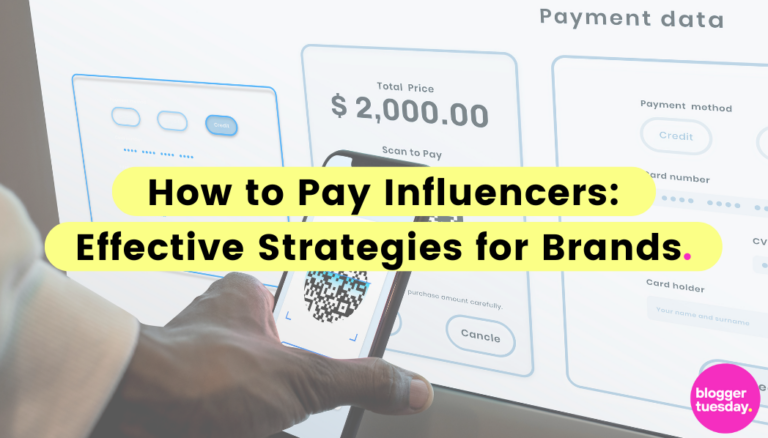
Influencer marketing has become the go-to tool for a lot of brands in 2025. Instead of using in-house marketing departments, they’re going through the social media personalities their audiences trust.
Figuring out how to pay influencers, though, can be challenging. You don’t always know how to approach it.
Unfortunately, payment strategies are key for maximising campaign success and maintaining positive relationships with the influencers you use. If you don’t get it right, you will make your marketing efforts will be far less effective.
Financial Planning For Influencer Campaigns
Planning influencer campaigns is just as critical as any other marketing drive. You need to ensure your money goes to good use.
In terms of payments, brands will usually test different models to see what works. Not all influencers want the same approach.
The most popular payment models are:
- Flat fees: You pay the influencer a fixed amount in return for their services.
- Pay-per-post: Another flat-fee-style arrangement where you pay per promotion or sponsorship
- Affiliate commissions: A percentage fee you agree on each sale of your products or services caused by the influencer
- Product gifting: Providing influencers with payment-in-kind in the form of products to test and share with their audiences
Most highly successful influencers use a pay-per-post model where you provide them with money and they include a product mention or review in their content. For example, you might pay an angling channel on YouTube $5,000 for a fishing rod product placement in one of their videos.
Try to align your payment method with what the influencer wants and expects. Don’t offer an affiliate deal to an internet personality who only accepts flat fees or large per-post payments.
When setting a budget for this type of marketing, also consider how valuable the influencer is to you. Try to avoid paying them more than they are worth.
Usually, the price you pay will depend on the value they can offer you, including:
- Their reach (how many people view or read their content)
- Their engagement rates (the percentage of their audience that interacts with their content)
- Your campaign goals (how much you want to achieve in a given timeframe)
- Industry benchmarks (what other brands in your niche are paying)
By combining these four factors, you will arrive at a figure telling you what you should pay each influencer. Then, you can decide whether it is worth it for your business as a whole. Sometimes, alternative marketing methods will offer better value.
Payment Logistics: How To Structure And Negotiate Payments

Choosing the right payment structure for your campaigns is essential. Simply paying an influencer a flat, upfront fee to work with you isn’t always the best strategy.
Choosing the right payment structure for your campaigns can help you generate more value for your brand. It can also make the influencer happier to work with you.
Payment Structure Options
We suggest exploring various payment structure options. Most brands work on some form of “performance-based” methodology, considering factors like views, engagement, and watch duration.
Performance-based is often the safest approach for businesses because it means you only pay for what you get. It can also work for influencers, since they have an incentive to improve their content to earn more.
Fixed payment structures are another option. These are harder to align with your campaign objectives, but it can be done. For example, you might pay a fixed fee and then use performance metrics to determine whether you should continue the relationship after the first campaign.
Negotiation Tips
Dealing with influencers and negotiating a fair price can be challenging. Many will try to drive a hard bargain.
Fortunately, as a brand, you are often in control and can work with the influencer to ensure all parties are happy.
Here are some tips:
- Set clear expectations from the start on payment and what you expect from the influencer
- Be transparent about what you are willing to pay and how it aligns with industry standards
- Discuss the influencer’s unique advantage (if they have one) and what this might be worth to you
- Offer to pay extra based on campaign performance and codify it in a contract
Tools Required To Pay Influencers
The tools required to pay influencers are fairly minimal. As long as you are set up to transfer funds to other businesses, you should be okay.
Many influencers use digital wallets, including:
- PayPal
- Venmo
- Zelle
You can also pay influencers via influencer platforms, such as Billo and Afluencer. These allow you to discover influencers in your niche quickly, and pay a flat fee per piece of content. Such services also deal with the negotiation and rapport-building for you, essentially productising the process to make it easier.
Other than that, paying influencers should feel similar to any other contractor or supplier. Simply use your regular invoicing software.
How To Evaluate Campaign Success

After you complete an influencer campaign, you need to evaluate its success. You want to figure out whether it was worth the money (or if you should hold onto your marketing budget for something else).
The primary metric is return on investment (ROI). This statistic tells you if you earned more money than you spent on an influencer, or not.
Your ROI depends on measurable goals, like target sales. However, you can also measure return on investment via indirect metrics, such as website traffic and brand impressions (since you can work out what each extra visit or brand impression is worth to you).
Suppose, for instance, your goal is “engagement.” If you care about this, you should track:
- Shares
- Likes comments
- Saves
These tell you if the influencer is connecting with your audience. Some influencers can generate a lot of views, but they don’t necessarily impact the people you want to sell to.
For sales-driven campaigns, you want to monitor click-through rates and conversions via tracking links or promo codes. These tell you directly what an influencer campaign is worth (instead of trying to work it out by proxy).
Numerous tools help you do this including:
- Your in-house affiliate platform (if you have one)
- Bitly
- Google Analytics
Keeping a close eye on these provides more information about the effectiveness of the influencer. It also allows you to pay them a commission that corresponds to their value.
You can also evaluate influencers for their impact on brand sentiment. Analysing comments and mentions (using brand mention tools) gives you a clearer picture on how your audience perceives you.
If you want to simplify the process of evaluating influencer value, you can use Upfluence, Aspire, Hootsuite, or any of the other marketing platforms mentioned in this guide. These provide various metrics that can sometimes help simplify your ROI calculations. Many of these tools have advanced data dashboards of their own where you can see the impact of your campaigns and how they performed over time.
You can also calculate your ROI by hand if you have the relevant metrics. Start by subtracting the campaign cost from the revenue it generated, then divide it by the campaign cost and multiply by 100 to get a percentage. Ideally, you want a number above 50% (meaning that you got back 50 pence on every pound you spent).
Keep coming back to these statistics to check progress. Measuring ROI consistently will tell you what is achievable, and what to expect.
Legal Considerations For Influencer Agreements
Even if influencers seem like an informal form of marketing, legal considerations are critical. Like any other contractor, you need to take these seriously.
Here’s what to consider:
Scope
You should start by defining the “scope” of the work you want the influencer to carry out. This can be as narrow or as wide as you want (as long as they agree).
For example, you could commission them to provide you with a product placement in one of their upcoming videos. You might tell them that it needs to be 60 seconds long and weaved into the existing content naturally.
Alternatively, you could ask that they work with you full time on multiple promotions, paying them a commission that scales with results. For instance, you might say you want consistent brand mentions in all their content, including at the start.
Think of scope as the value that the influencer provides you with. How much of their audience’s time and attention will they focus on your brand or what you sell? The more of this you demand, the more the influencer can charge.
Deliverables
Deliverables are the specifics that you require from the influencer. These could include:
- A review of a product for a video in the next week
- A brand mention or product placement on an Instagram reel
- A native ad where they discuss your brand in their voice, following a script you provide
Payment
You should include payment details in the contract. These should spell out what you offer without any room for misinterpretation.
Intellectual Property Rights
If you are using influencers, usually it is their responsibility to ensure their content doesn’t breach any copyright laws. However, you should also allow them to use your materials if you feel it will help your brand. If you don’t, they could get a strike against their account.
Local Advertising Laws
Finally, explore local advertising laws to see if your campaign falls within them. Understanding these protects both you and the influencer from legal action.
How To Build A Long-Term Partnership With An Influencer
As a company, you don’t always want to run one-off campaigns. Sometimes, it is better to work with an influencer long-term. But how?
The best way to do this is through fair compensation. You want to pay the influencer what they’re worth to encourage them to stick around.
Benefits Of Ongoing Collaborations
The benefits of ongoing collaborations can be substantial if you get them right. Audiences like it when an influencer consistently champions your products and services over a longer period, because it shows they trust you.
It’s also authentic. Instead of using an influencer for a week and then dropping them, using them for longer demonstrates to audiences that you have something they want. You aren’t looking for quick sales here and there, but adding consistent value.
Tips For Maintaining Relationships With Influencers Beyond A Single Campaign
So, what can you do to maintain a relationship with an influencer beyond a single campaign?
Ensure Transparent Compensation
Always ensure that the influencer knows how much you intend to pay them. It should be clear what they get out of the relationship so they know how much effort they need to commit to it.
How much you pay should depend on the influencer’s performance and the effort you want them to put in. You can also link it to campaign goals (if targeting sales).
Communicate Consistently
You also want to communicate with influencers consistently. Going weeks without a text message or email can feel odd to many social media personalities.
Therefore, check in with them on a regular schedule, even outside active campaigns. Always speak to them as a person and avoid sending them generic scripts.
If you can show genuine interest in their work, that’s even better. This approach shows them that you care about what they do, particularly if you like or share their content.
Provide Creative Freedom
Lastly, ensure you provide them with creative freedom. Try to avoid the temptation to control every aspect of what they do. After all, their originality and flair is probably what gained them their social media followings in the first place.
You can still provide guidelines and audit their content, but just don’t micromanage.
Now You Know How To Pay Influencers
Reading through this article, you should now have a clearer picture of how to pay influencers. It’s critical to set your expectations at the right level so you can get the best from the people you work with. Always think about how much you need to pay, the quality of your communication, and the legalities of entering a relationship like this.


